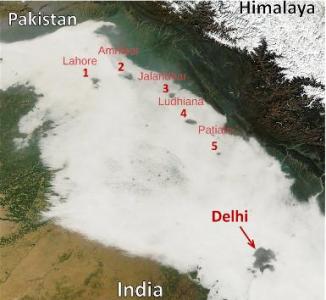
The persistence of fog over urban areas is suppressed due to increase in land surface temperature, reveals study
The winters of North India are always in the news. Chilling cold fronts and thick fog in cities like Delhi disrupt trains, air traffic and day-to-day lives of many. An accurate prediction of fog goes a long way in planning transport and other activities in this region. A study by researchers at the Indian Institute of Technology Bombay has revealed another contributor that affects fog---the urban heating. Increased land surface temperature in cities is dispering the fog cover quicker than in the surrounding rural areas, leaving holes in fog as big as the size of Delhi when viewed from space.
Fog is a low lying cloud formed from condensation of moisture. The availability of significant moisture from agricultural land, water bodies, supported by calm winds in North India leads to dense fog formation. Though at times a nuisance, it plays a vital role in the ecology of the region and favours the growth of some fruit trees.
The researchers used NASA’s Moderate Resolution Imaging Spectroradiometer (MODIS) satellite data of over a period of 17 years (2000-2016). They observed ‘fog holes’ occurring over urban areas of the Indo Gangetic plains, the most prominent one over Delhi. A fog hole is a variable sized open patch in an extensive fog cover.
The study, published in the journal Geophysical Research Letters reveals that the geographical extent of the ‘fog hole’ is highly correlated with the population of a city. Larger the city population, larger is the fog hole. “A strong correlation between the fog hole area and populations was observed from 13 global cities representing USA, Europe and Asia. Delhi’s urban heat appears to have the strongest impact on the suppressed fog formation, when compared globally”, says Ritesh Gautam, formerly professor at IIT Bombay, who led the study.
So, how does heat exactly affect the formation of fog? In rural areas, temperatures remain cooler along with sufficient moisture availability from higher green cover. Due to intense urbanisation, cities are generally warmer than rural areas, especially during winter months. There is also a relative lack of vegetation cover (for example trees, croplands, grass cover) within city premises, which lead to low relative humidity inside cities compared to rural areas, that can lead to sharp differences in fog formation across urban- rural landscapes. “The fog hole phenomenon, especially over Delhi, is so strong that it causes nearly 50% reduction in fog frequency compared to Delhi’s surroundings, seen over the 17-year period (2000-2016)”, remarks Prof. Gautam.
The study notes that aerosols (suspended fine particles such as those coming from urban pollutants) in the air are known to increase or intensify fog development. However, the effect of urban heating seems to be more dominant than the effect of aerosols, and effectively causes fog holes, say the authors.
This finding can have considerable impact on fog prediction. “The findings from the study are in the direction of the better understanding of fog processes and highlights the specific impact of urban heating on fog. Developing a sophisticated prediction system which accounts for the impacts of both air pollution and urbanisation can improve fog forecasting capability”, adds Prof. Gautam.
The findings render clear evidence of the impact of urban heating over cities in causing fog holes. As Prof. Gautam points out, “Fog is a regional issue and not just a local issue”. The fact that fog is of ecological importance has a significant impact on life in the northern plains, calls for an in-depth study of fog formation processes and the impact of air pollution and urbanization on fog in not just the urban areas of Delhi, but also other parts of North India.
Prof. Ritesh Gautam
